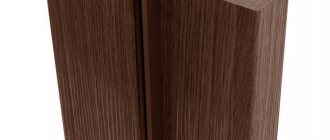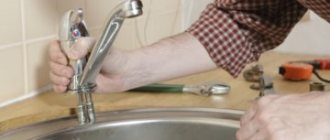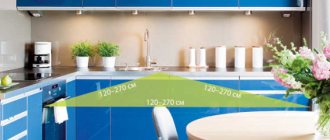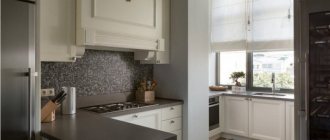Basic rules for choosing a location
For any installation, you need to take into account the features of the room:
- what flooring is in the apartment - quality, material, presence of differences (the latter is relevant for “Khrushchev” buildings),
- is there a dedicated wire from the input electricity meter,
- how far away are sockets, heat and water sources,
- and how the unit will look in the interior with existing furniture.
Let's look at the rules in order.
Floor - durable
Before installing indoors, carefully examine the floors - they must be strong enough and motionless. You cannot install a large-sized refrigerator on a coating that is soft (4-5 layers of linoleum) and springs freely - for example, on boards up to 3 cm thick, located with a large gap. Due to vibration, the motor will hum louder, especially at night, and will soon fail.
If the covering is plank and springy, protect the floor surface with plywood at least 4-5 mm thick.
It is better to install the equipment on concrete - such a floor will withstand even a two-door, two-chamber unit of maximum height. The coating can be finished in any way, but for large equipment a tiled base is more suitable.
Warmth - away
To install a freezer and refrigerator, consider areas of the room far from heat sources. If you do not follow this rule, the unit will quickly fail. The compressor operates constantly, because the device heats up, as a result, the air inside the chamber needs to be cooled regularly. If used for a long time in such conditions, the thermostat fails, and soon the engine fails.
When installing a refrigerator, you should consider the location of the window in the room.
For the same reason, refrigerators and freezers are not placed near windows - in the summer they heat up just like radiators and break down faster. The exception is cases when there is an air conditioner in the room.
It is also impossible to place such equipment next to a gas or electric stove - if the stove is used frequently, it generates a lot of heat.
Minimum distance from heat sources: from the radiator - 30 cm, from the stove - 50 cm.
Sockets - closer
Pay attention to the presence of sockets nearby. The best option is to have a power source near the device.
- Include a direct wire from the electrical panel into the project during the construction phase.
- Buy sockets with grounding (small antennae on the body).
- But even if there is no outlet nearby, do not use multiple extension cords. All the energy from them will accumulate on the first “tee” connected to the plug, the network will be overloaded - and this is a serious risk of fire.
Water is the enemy
Do not install the refrigerator near sinks, taps, washing machines and water pipes: even if they are not close together, splashes will still reach the refrigerator - and you will receive an electric shock from the body. The ideal distance from the water is 2-3 m.
Refrigerator - in a niche where the former corridor used to be
Tiny kitchens push owners to take extreme measures - remodeling. Especially after living with a refrigerator at a distance, when you have to run to the next room either for butter or for vegetables. A niche resulting from moving a wall or eliminating closets can be a great place for the right assistant.
The advantages of this option are obvious - the useful area increases, inspiration appears and several decisions are made at once regarding the placement of kitchen furniture.
In this case, you need to start from the size of the niche, using it to the maximum. Usually the width of the niche is made slightly larger than the width of the refrigerator. Those. if you bought a standard 60 cm size refrigerator, then make a niche 65-70 cm.
The main disadvantage is that you will have to communicate for a long time on the issue of redevelopment. Then you will have agonizing waits for the realization of your plans. But the result will please you and make the kitchen cozy and comfortable.
Instructions for correct installation
Usually, household appliances come with instructions with detailed rules for transportation, installation, first use and maintenance. If you don't have it at hand, follow the rules:
- If the refrigerator was transported horizontally, wait two to three hours before using it for the first time.
- The recommended distance from the wall to the rear panel of the unit is 10 cm. 5 cm is possible, but air microcirculation will worsen.
- Provide free access - the door should open freely to the maximum angle.
- To prevent slipping, use silicone or plastic stickers on the floor - the unit will make less noise and will not “run” around the kitchen.
- There should be no sofa or kitchen corner near the appliance. If it is not possible to change the layout of the furniture, it is recommended to position the refrigerator so that the distance between it and the interior items is at least 10 cm.
If you follow these rules, the risk of overheating of the mechanism, loss of power, failure of the defrost timer or other components is reduced.
How to move or relocate correctly
The refrigerator can be rolled around the kitchen using a pair of rear wheels. We tilt it back a little and pull the lower part towards us.
Avoid sharp tilts - the device can be dropped onto the floor with its radiator. After such a fall, not all units continue to work; repairs are often required.
Secure the power cord to the grille on the back of the device. If the wire drags along the floor, it is easy to break it, break it, or damage the insulation. For fixation, fasteners are used - plastic clamps.
Electricity and cables
To ensure safe operation of the device, connect it to the electrical panel via a circuit breaker (RCD). Ideally, allocate a separate outlet for the refrigerator. As a last resort, use an extension cord - but only one.
If you cannot connect the unit to a separate outlet, use a surge protector - it will ensure the safety of equipment of any brand (AEG, Beko, Electrolux, LG, Indesit, Samsung, Whirlpool, Bosch, etc.). If there is a voltage drop, the external fuse will burn instead of the delicate electronics.
Alignment by level
Install the refrigerator in the chosen place so that it stands motionless and level, otherwise it will beat, “jump” and “walk” around the kitchen. The fact is that during operation of the compressor the device vibrates, so on an uneven surface it constantly moves. This negatively affects the main nodes.
Adjusting the front legs
Adjust the position of the front legs so that the refrigerator doors close automatically under their own weight. The legs are two plastic washers with bolts located at the bottom front. They allow you to change the angle of inclination of the unit by 1–2 degrees. The magnetic seal will do its job and seal the chamber.
If the floor is flat, without drops (for example, self-leveling or industrial), simply place the equipment in the right place and adjust the position of the front legs. If the floor is uneven, check the slope using a building level.
- Tilt the device back slightly so that your feet are in the air.
- Manually rotate them clockwise (to decrease the height) or counterclockwise to achieve the optimal position.
- Carefully lower the equipment and check the bubble at the construction level.
The final stage
- As a final step, install the shelves in the upper compartment and the drawers in the freezer.
- Change the position of the thermostat by selecting medium temperature mode.
- Perform the first startup of the device, plug the plug into the socket.
Adjusting the temperature in refrigerators of different brands
It is recommended to check the condition of temperature regulators if refrigeration equipment is not functioning correctly. Common manifestations of changes in thermostat settings are as follows:
- inaccuracy of temperature values inside the chamber;
- melting of ice build-ups in a low-temperature chamber;
- the appearance of a snow “coat” or ice on the internal surfaces of the refrigeration chamber;
- high power consumption;
- lack of power supply after disconnecting the unit.
The thermostat setting option depends on the technical parameters and design of the refrigeration unit. Modern models of refrigeration equipment allow you to regulate temperature values separately in different compartments, inside the refrigerator compartment and in the low-temperature chamber.
Beko
The optimal temperature value inside the Beko refrigerator is +5 C. The temperature can be adjusted using a mechanical thermostat, the maximum value of which is marked “5”. For normal operation, set the average value to “3”.
Attention! It is not recommended to load hot foods into the low-temperature compartment to prevent the thermometer in the refrigerator compartment from dropping to the highest level. If you neglect this rule, the thermostat will be overloaded.
Bosch
Modern Bosch refrigeration equipment is equipped with an electronic screen on which it is possible to set the temperature values in the chamber. To make edits and adjust the temperature, press the button and wait until the required temperature symbol is displayed on the panel. When temperatures drop in the refrigerator compartment, the cold flow in the low-temperature compartment increases. The temperature indicator for the refrigerator compartment must correspond to +4 ̊С.
Daewoo
The temperature regulator screen in refrigeration equipment manufactured by Daewoo is located on the front surface of the low-temperature compartment. Additionally, there is a cold air flow regulator in the freezer compartment. The unit is equipped with 4 temperature modes:
- min – the lowest performance indicators of the unit;
- med – average performance indicators;
- max – the greatest productivity of the refrigerator in terms of cold;
- super is an automatic indicator that is set at room temperatures up to 10 °C.
Temperature values are set using the “Temp” button. According to the instruction manual, when pressed successively, the screen will display the modes in order. When you select the “Fuzzy Control” mode using the “Fuzzy” key on the outside panel, the correct temperature inside the chambers will be automatically determined in accordance with the thermometer reading in the room where the refrigerator is located.
Eniem
Outdated two-chamber refrigerated cabinets Enim, as well as units produced by Minsk, are equipped with a mechanical temperature regulator in the rotating wheel version. The thermostat is located in the upper right part of the refrigerator compartment and has 7 positions. To change the temperature settings, scroll the regulator to the required value.
Helkama
Helkama household refrigerators with one chamber, having a mechanical thermostat with 5 position options. Located on the right side inside the refrigerator compartment. To correctly change the temperature values, turn the thermostatic wheel clockwise to achieve the best possible supply of cooled air masses.
LG
The refrigeration equipment is equipped with an electronic screen with separate controls for different compartments. By pressing a button on the panel it is possible to set the required temperature values. Outdated units with a mechanical thermostat, made in the roller version, operate in three modes:
- min – lowest cooling rates;
- med – average temperature inside the chambers;
- max – the highest productivity of the unit in terms of cold.
Attention! In modern units, the user can set separate temperature indicators for the freshness zone (zero chamber) “Fresh Converter”, selecting a specific mode to prevent spoilage of meat products, fish, vegetables and fruits.
Nord
Nord refrigeration equipment can be characterized by the external and internal position of temperature regulators. When the thermostat is located outside, it is made in the form of a rotating disk with 3 positions, and if inside the chamber, the performance is increased by turning the thermostatic wheel clockwise.
Samsung
In Samsung refrigeration equipment, when defrosting No Frost, electronic controls are provided for the refrigeration compartments and low-temperature. The gearbox is located at the top of the panel. In the case of older models, there is manual control with 5 positions. To improve performance, it is rotated clockwise.
Atlant and Ariston
Hotpoint-Ariston and Atlant units are mostly not equipped with electronic displays. Such cabinets have two rollers for temperature calibration with digital mode marks. Regulators are located in the lower and upper chambers of the devices. When scrolling clockwise, performance increases.
Biryusa
The temperature values in Biryusa household appliances are regulated using a relay knob, which increases the cooling output clockwise. Modern models contain thermostats that move left and right and increase or decrease the size of the pan to increase or decrease the volume of incoming cold air masses.
Indesit
Indesit units are mostly characterized by a manual regulator for calibrating the temperature in the refrigeration and low-temperature compartments. The roller in some configurations of Indesit refrigerators does not have digital values. The increase and decrease in temperature values corresponds to the level of tilt of the handle - the more the thermostat is turned, the greater the volume of cold air enters the compartment.
Features of connecting equipment with an ice maker
Some models of “refrigerated trucks” have an ice maker - a device for creating ice of various shapes and purposes (food, technical). The generator can be a bulk generator - you pour water into a special container yourself - or a stationary one, connected to a water supply.
If you have a tankless generator, carefully align the refrigeration housing relative to the horizon - misalignment will lead to liquid spills and other problems. Stationary requires connection to a power source and water supply.
There are large two-door refrigerators with a No Frost system and an ice maker - they are connected according to the standard scheme. Do not forget that such units should be located far from the heat source.
How to put a microwave on top and is it worth it?
In small apartments, a microwave oven is often placed on top of the refrigerator. This makes sense if the unit is small and you will only heat and defrost food in the oven. Other microwave functions—long cooking, grilling, multicooking, and others—will quickly lead to overheating of the device.
Consider other rules:
- the distance from the wall to the microwave is the same as that of the refrigerator: 10–15 cm;
- Lay plywood or plexiglass between electrical appliances. Film, oilcloth and other flammable materials - under no circumstances;
- The microwave should be equipped with legs so that the gap between the units helps to increase air circulation.
Stages of connecting a refrigerator by level
How to properly level a refrigerator? Proper placement affects work time and safety. Installing the refrigerator at a level will ensure long service life of the refrigeration unit.
So where should a refrigerator stand? Slanted or level? Almost every refrigerator is equipped with legs that adjust its position. By changing the height of the legs, we place the device with a slight slope back so that the door can close itself under its own weight.
The permissible tilt of refrigeration equipment is no more than 15° . Under no circumstances should the device be tilted more than 40° degrees, as this will cause damage to the compressor.
Place the refrigerator on a flat surface. To prevent the equipment from slipping, you can purchase special stickers for the legs. The appliance must stand firmly and not wobble when the door is opened. The legs can be adjusted with a special key or manually.
How to adjust the refrigerator:
- choose a suitable place;
- check if the floor is level;
- install the refrigerator;
- adjust the legs.
To connect the device by level, you need to prepare the following materials:
- height adjustment key;
- ink;
- container for liquid.
How to level a refrigerator:
- pour water into a container and dissolve ink in it;
- place the contents at the bottom of the refrigerator;
- align using a tool, focusing on the liquid.
If there is a building level, place it parallel to the front wall of the refrigeration equipment. Tighten the screws (legs) to level the position of the device. In this case, we level the lateral slope.
Then we place the level parallel to the side wall to level the slope in front and behind. We check everything again to remove inconsistencies, if any. When the job is completed, the building level air bubble should be in the middle in both positions.
Attention! The front legs should be slightly higher than the back legs. In this case, the door will close tightly.
Installation of a built-in refrigerator
The main rule when installing refrigeration equipment is to leave gaps for air circulation. This will help avoid overheating. If the unit is built into a cabinet, there should be gaps of at least a few centimeters on all sides. The cabinet where the built-in refrigerator is located should not be completely closed - take a cabinet with a missing back wall.
There is a shelf at the bottom of the furniture cabinet, with ventilation holes underneath it. A gap of up to 10 cm is left above the equipment.
All other installation rules (closer to outlets, further from heat and water, at a distance from furniture) also apply. Decide in advance how you will connect the cable - from above or below the device.
Instructions for installing the unit inside the cabinet:
- Check the dimensions of the device and the kitchen cabinet. Check if there are gaps on all sides.
- Place the device in the pencil case.
- Attach the front and doors.
- Install decorative and protective elements.
- Connect to the network.
External door
If you want to completely integrate the refrigerator into the cabinet of the kitchen unit, choose the method of fastening the door:
Possible options:
- installation of runners on the cabinet door;
- the door remains motionless relative to the cabinet door.
In the first case, when opening, the door smoothly slides along one or two guides (the exact number is determined by the height of the cabinet). There is no need to fix the door - it will move itself when opened. To do this, a metal corner connected to the guide is fixed on the door.
More details in the video from YouTube:
If you plan to build in the “refrigerator” incompletely, a door is not needed - the refrigeration unit will be located in an open cabinet without doors or separately from the unit.
To ensure that the installation does not stand out from the overall design of the room, we recommend:
- paint to match the kitchen unit, kitchen walls, electric stove;
- cover with polymer film;
- cover the outer wall with a chalk board.
Sockets for electrical appliances and household appliances must be located in an open area.
Electrical connection
The main rule at this stage is to ensure free access to the outlet.
When connecting the refrigerator, remember:
- you cannot close the socket, because of this you will not be able to pull out the plug in time in the event of a short circuit or breakdown, you will have to move the device away from the wall;
- a limited amount of equipment is connected to the extension cord (no more than 2 units), since otherwise the load on the cable increases;
- the socket should be located under the tabletop, above or on the side;
- do not forget about working grounding.
Run the extension cord along the baseboard behind the kitchen unit - this will increase the safety of the electrical appliance and reduce the risk of injury if a person catches their foot on the cable.
The presence of a circuit breaker in the refrigerator connection circuit allows you to prevent equipment breakdowns during voltage surges, thunderstorms, flooding and other emergency situations.
Where to put the refrigerator
How to place a refrigerator in a small kitchen is well illustrated in the photo. Despite the small size of the kitchen, you can find an opportunity. In this case, you need to know where the refrigeration unit cannot be placed:
- In direct connection to the stove - gas, electric.
- Near a radiator or other heating device. Changes in air temperature will quickly damage the refrigerator.
- Near the sink - excessive humidity also negatively affects the normal operation of the refrigerator.
- In a place where direct sunlight hits.
Most often, a refrigerator in a small kitchen is placed in the corner near the window.
Important! Overheating and temperature changes are detrimental to the refrigerator.
Based on this, the choice of place where you can place a refrigerator in a small kitchen, at first glance, is small. However, even within a small space you can find a place where it will not look like an alien object.
If you don’t have enough space for a refrigerator in the kitchen, you can find a refrigerator of a non-standard shape.
In a niche
A niche can be created by the shape of the kitchen itself. If it is small, perhaps a large unit will fit in a small kitchen, as, for example, in the photo - it is important to choose its dimensions correctly.
In a small kitchen, you can provide a niche in the furniture for a convenient location of the refrigerator
A niche can be provided by ordering a kitchen set according to the size of the kitchen:
- If the refrigerator is tall, you can provide an open shelf or mezzanine on top;
- If you have chosen a small unit, small cabinets can also be provided below, under the refrigerator - for example, for storing potatoes and vegetables.
Built-in appliances look very neat and are almost invisible in the kitchen interior
Built-in refrigerator
Another successful option for installing refrigeration equipment is installation under a kitchen window. A very convenient option if your kitchen is located next to a balcony or loggia.
By removing the block under the window, a small refrigerator can be placed in the resulting opening.
True, at the same time, you need to be careful when choosing it, because most of the options on the market are of the vertical type.
You can close the refrigerator with the doors of the kitchen unit, then it will become a uniform element of the furniture “wall”.
Under the table
A small refrigerator can be placed either under the worktop in a kitchen unit or in an island table. In this case, it is possible to choose three technology options:
- Only a small refrigerator;
- Refrigerator with small freezer drawer;
- Two separate units - a refrigeration and a freezer, one of which can be moved outside the kitchen.
The built-in refrigerator in a small kitchen, as seen in the photo, fits harmoniously into the interior without disturbing the overall design.
Outside the kitchen
If your kitchenette borders on a balcony or loggia, an excellent option is to move the unit there, then there will be no question of where to put the refrigerator in a small kitchen. The photo shows how well the refrigerator can be positioned by moving it outside the kitchen area.
Important! You can take the refrigerator out onto a glazed balcony or loggia only after insulating it first.
You can take the refrigerator out not only to the balcony: by placing it in a room or hallway, you will save space in a small kitchen, although at the expense of convenience. At the same time, you also need to think about how it doesn’t look like a foreign object there. Everything that was previously said about the possibility of disguising the refrigerator in a niche or behind the doors is appropriate here.











